Transcription program of red sea bream iridovirus as revealed by DNA microarrays
- PMID: 16306587
- PMCID: PMC1316049
- DOI: 10.1128/JVI.79.24.15151-15164.2005
Transcription program of red sea bream iridovirus as revealed by DNA microarrays
Abstract
Red sea bream iridovirus (RSIV) has been identified as the causative agent of a serious disease in red sea bream and at least 30 other marine fish species. We developed a viral DNA microarray containing 92 putative open reading frames of RSIV to monitor the viral gene transcription program over the time course of an in vitro infection and to classify RSIV transcripts into temporal kinetic expression classes. The microarray analysis showed that viral genes commenced expression as early as 3 h postinfection (p.i.) and this was followed by a rapid escalation of gene expression from 8 h p.i. onwards. Based on the expression of some enzymes associated with viral DNA replication, the DNA replication of RSIV appeared to begin at around 8 h p.i. in infected cells in vitro. Using a de novo protein synthesis inhibitor (cycloheximide) and a viral DNA replication inhibitor (phosphonoacetic acid), 87 RSIV transcripts could be classified into three temporal kinetic classes: nine immediate-early (IE), 40 early (E), and 38 late (L) transcripts. The gene expression of RSIV occurred in a temporal kinetic cascade with three stages (IE, E, and L). Although the three classes of transcripts were distributed throughout the RSIV genome, E transcripts appeared to cluster in at least six discrete regions and L transcripts appeared to originate from seven discrete regions. The microarray data were statistically confirmed by using a t test, and were also clustered into groups based on similarity in the gene expression patterns by using a cluster program.
Figures
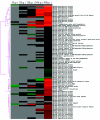
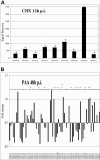
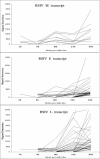
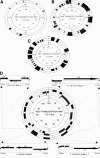
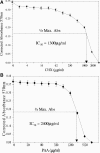

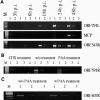
Similar articles
-
Characterization of a new fibroblast cell line from a tail fin of red sea bream, Pagrus major, and phylogenetic relationships of a recent RSIV isolate in Japan.Virus Res. 2007 Jun;126(1-2):45-52. doi: 10.1016/j.virusres.2006.12.020. Epub 2007 Mar 1. Virus Res. 2007. PMID: 17335926
-
Whole-genome transcriptional profiles of a novel marine fish iridovirus, Singapore grouper iridovirus (SGIV) in virus-infected grouper spleen cell cultures and in orange-spotted grouper, Epinephulus coioides.Virology. 2008 Jul 20;377(1):39-48. doi: 10.1016/j.virol.2008.04.011. Virology. 2008. PMID: 18555886
-
Complete genomic DNA sequence of rock bream iridovirus.Virology. 2004 Aug 1;325(2):351-63. doi: 10.1016/j.virol.2004.05.008. Virology. 2004. PMID: 15246274
-
Application of the arming system for the expression of the 380R antigen from red sea bream iridovirus (RSIV) on the surface of yeast cells: a first step for the development of an oral vaccine.Biotechnol Prog. 2006 Jul-Aug;22(4):949-53. doi: 10.1021/bp060130x. Biotechnol Prog. 2006. PMID: 16889368
-
[Red sea bream iridoviral disease].Uirusu. 2005 Jun;55(1):115-25. doi: 10.2222/jsv.55.115. Uirusu. 2005. PMID: 16308538 Review. Japanese.
Cited by
-
Transcriptional profiling of Marek's disease virus genes during cytolytic and latent infection.Virus Genes. 2008 Apr;36(2):383-92. doi: 10.1007/s11262-008-0203-7. Epub 2008 Feb 12. Virus Genes. 2008. PMID: 18266100
-
Global Transcriptomic Analysis of Interactions between Pseudomonas aeruginosa and Bacteriophage PaP3.Sci Rep. 2016 Jan 11;6:19237. doi: 10.1038/srep19237. Sci Rep. 2016. PMID: 26750429 Free PMC article.
-
Mandarin fish caveolin 1 interaction with major capsid protein of infectious spleen and kidney necrosis virus and its role in early stages of infection.J Virol. 2013 Mar;87(6):3027-38. doi: 10.1128/JVI.00552-12. Epub 2013 Jan 2. J Virol. 2013. PMID: 23283951 Free PMC article.
-
Microarray analysis of Paramecium bursaria chlorella virus 1 transcription.J Virol. 2010 Jan;84(1):532-42. doi: 10.1128/JVI.01698-09. J Virol. 2010. PMID: 19828609 Free PMC article.
-
Identification of the VP92R gene from infectious spleen and kidney necrosis virus.Virus Genes. 2010 Oct;41(2):210-7. doi: 10.1007/s11262-010-0502-7. Epub 2010 Jun 25. Virus Genes. 2010. PMID: 20577793
References
-
- Bowtell, D., and J. Sambrook (ed.). 2002. DNA microarrays: a molecular cloning manual. Cold Spring Harbor Laboratory, Cold Spring Harbor, N.Y.
-
- Byon, J. Y., T. Ohira, I. Hirono, and T. Aoki. 2005. Use of a cDNA microarray to study immunity against viral hemorrhagic septicemia (VHS) in Japanese flounder (Paralichthys olivaceus) following DNA vaccination. Fish Shellfish Immunol. 18:135-147. - PubMed
-
- Caipang, C. M., I. Hirono, and T. Aoki. 2003. Development of a real-time PCR assay for the detection and quantification of red sea bream Iridovirus (RSIV). Fish Pathol. 38:1-7.
Publication types
MeSH terms
Substances
LinkOut - more resources
Full Text Sources

